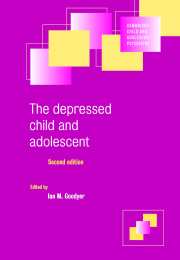Book contents
- Frontmatter
- Contents
- List of contributors
- Preface
- 1 Historical aspects of mood and its disorders in young people
- 2 The development of emotional intelligence
- 3 Developmental precursors of depression: the child and the social environment
- 4 Physiological processes and the development of childhood and adolescent depression
- 5 Childhood depression: clinical phenomenology and classification
- 6 The epidemiology of depression in children and adolescents
- 7 Family–genetic aspects of juvenile affective disorders
- 8 Life events: their nature and effects
- 9 Adolescent depression: neuroendocrine aspects
- 10 Suicidal behaviour in adolescents
- 11 Psychopharmacology of depressive states in childhood and adolescence
- 12 The psychotherapeutic management of major depressive and dysthymic disorders in childhood and adolescence: issues and prospects
- 13 Natural history of mood disorders in children and adolescents
- Index
7 - Family–genetic aspects of juvenile affective disorders
Published online by Cambridge University Press: 18 December 2009
- Frontmatter
- Contents
- List of contributors
- Preface
- 1 Historical aspects of mood and its disorders in young people
- 2 The development of emotional intelligence
- 3 Developmental precursors of depression: the child and the social environment
- 4 Physiological processes and the development of childhood and adolescent depression
- 5 Childhood depression: clinical phenomenology and classification
- 6 The epidemiology of depression in children and adolescents
- 7 Family–genetic aspects of juvenile affective disorders
- 8 Life events: their nature and effects
- 9 Adolescent depression: neuroendocrine aspects
- 10 Suicidal behaviour in adolescents
- 11 Psychopharmacology of depressive states in childhood and adolescence
- 12 The psychotherapeutic management of major depressive and dysthymic disorders in childhood and adolescence: issues and prospects
- 13 Natural history of mood disorders in children and adolescents
- Index
Summary
Introduction
Important among the distinguishing features of juvenile mood disorders are significant social morbidity, protracted courses of recovery, possibly indicative of greater resistance to currently available treatment modalities, an unusually high propensity for manic switches, and episode recurrence (Birmaher et al., 1996; Strober, 1996). These sobering ‘truths’ are underlined further by epidemiological data showing that affective disorders are becoming increasingly prevalent in the juvenile population, suggesting earlier ages of onset in those at risk (Klerman & Weissman, 1989). Factors accounting for these temporal changes in rates of illness are little understood, although both genetic and environmental effects can be assumed. The validity of these conditions as diagnostic entities in young people remains an important area for further research.
Disturbances of mood in young people encompass a wide range of clinical phenomena and associated risk factors. Similarities in the syndromic expression of depression in juveniles and adults are well documented (Ryan et al., 1987), but homogeneity of phenotype does not mean there is a single common disorder across all age groups. For example, while prepubertal major depression seems to breed true over time and recur through adolescence (Kovacs et al., 1984; Hammen et al., 1990), one follow-up study focusing on the adult psychiatric status of children and adolescents with depression showed that prospective continuity with adult major depression was considerably stronger among postpubertal subjects (Harrington et al., 1990). A subsequent analysis of data from this cohort illustrates, as well, how immensely important it is to take account of nondepressive comorbid states in mapping developmental linkages in efforts to establish nosological validity.
Keywords
- Type
- Chapter
- Information
- The Depressed Child and Adolescent , pp. 179 - 203Publisher: Cambridge University PressPrint publication year: 2001
- 2
- Cited by



